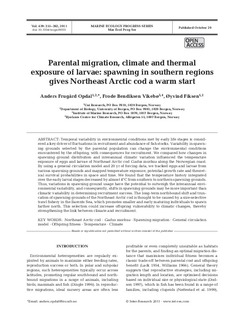| dc.contributor.author | Opdal, Anders Frugård | |
| dc.contributor.author | Vikebø, Frode | |
| dc.contributor.author | Fiksen, Øyvind | |
| dc.date.accessioned | 2012-11-13T18:20:57Z | |
| dc.date.available | 2012-11-13T18:20:57Z | |
| dc.date.issued | 2011-10-20 | |
| dc.identifier.issn | 0171-8630 | |
| dc.identifier.issn | 1616-1599 | |
| dc.identifier.uri | http://hdl.handle.net/11250/109154 | |
| dc.description.abstract | Temporal variability in environmental conditions met by early life stages is considered
a key driver of fluctuations in recruitment and abundance of fish stocks. Variability in spawning
grounds selected by the parental population can change the environmental conditions
encountered by the offspring, with consequences for recruitment. We compared how changes in
spawning ground distribution and interannual climatic variation influenced the temperature
exposure of eggs and larvae of Northeast Arctic cod Gadus morhua along the Norwegian coast.
By using a general circulation model and 20 yr of forcing data, we tracked eggs and larvae from
various spawning grounds and mapped temperature exposure, potential growth rate and theoretical
survival probabilities in space and time. We found that the temperature history integrated
over the early larval stages decreased by almost 4°C from southern to northern spawning grounds.
Thus, variations in spawning ground usage have the potential to outweigh the interannual environmental
variability, and consequently, shifts in spawning grounds may be more important than
climatic variability in determining recruitment success. The long-term northbound shift and truncation
of spawning grounds of the Northeast Arctic cod is thought to be caused by a size-selective
trawl fishery in the Barents Sea, which promotes smaller and early maturing individuals to spawn
farther north. This selection could increase offspring vulnerability to climatic changes, thereby
strengthening the link between climate and recruitment. | no_NO |
| dc.language.iso | eng | no_NO |
| dc.publisher | Inter-Research | no_NO |
| dc.subject | arctic cod | no_NO |
| dc.subject | arktisk torsk | no_NO |
| dc.subject | climate | no_NO |
| dc.subject | klima | no_NO |
| dc.subject | fish migration | no_NO |
| dc.subject | vandringer | no_NO |
| dc.subject | temperature | no_NO |
| dc.subject | temperatur | no_NO |
| dc.subject | spawning | no_NO |
| dc.subject | gyting | no_NO |
| dc.title | Parental migration, climate and thermal exposure of larvae: spawning in southern regions gives Northeast Arctic cod a warm start | no_NO |
| dc.type | Journal article | no_NO |
| dc.type | Peer reviewed | no_NO |
| dc.subject.nsi | VDP::Mathematics and natural science: 400::Zoology and botany: 480::Marine biology: 497 | no_NO |
| dc.subject.nsi | VDP::Mathematics and natural science: 400::Geosciences: 450::Oceanography: 452 | no_NO |
| dc.subject.nsi | VDP::Agriculture and fishery disciplines: 900::Fisheries science: 920::Fish health: 923 | no_NO |
| dc.source.pagenumber | 255-262 | no_NO |
| dc.source.volume | 439 | no_NO |
| dc.source.journal | Marine Ecology Progress Series | no_NO |
| dc.identifier.doi | http://dx.doi.org/10.3354/meps09335 | |
